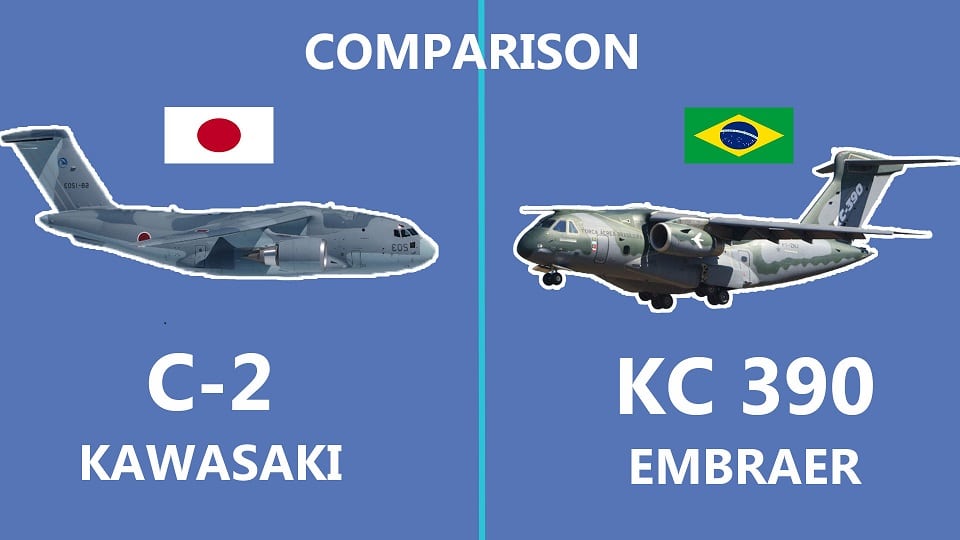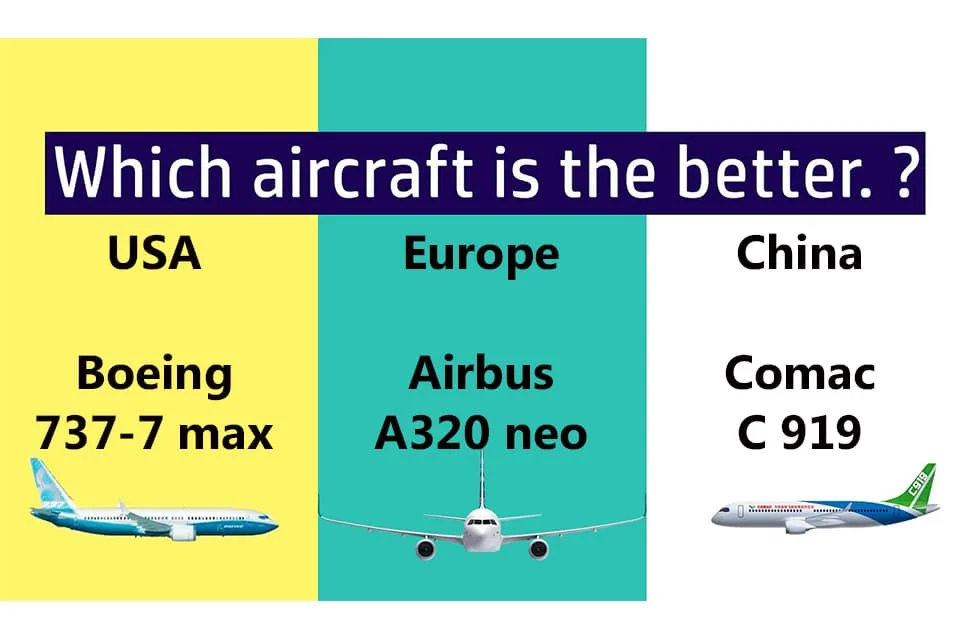Aircraft comparison
Aircraft comparison Brazil’s KC-390 vs Japan’s Kawasaki C-2
we’ll take a look at two different aircraft: the Brazilian-built Embraer KC 390 and the Japanese-built Kawasaki C2.

The military cargo plane is a crucial component of any nation’s defense since it helps move the troops and the military equipment to the necessary locations. Such military cargo jets are now in demand from several nations.
In this article, we’ll take a look at two different aircraft: the Brazilian-built Embraer KC 390 and the Japanese-built Kawasaki C2. We will comprehend aircraft specifications and their best-possible flying and serving capabilities for military needs.
Brazils Embraer KC -390
Embraer Aircraft, a Brazilian-based company with experience in the production of both private jets and commercial aircraft, is the manufacturer of the KC 390. A medium-sized twin-engine military transport aircraft, the KC 390. As of right now, it is the heaviest aircraft Embraer has ever produced.
China’s TP500 freight drone makes its maiden flight.(Opens in a new browser tab)
In order to identify the aircraft specifically, it was given a ‘Millennium’ name during the Dubai air show 2019. The Brazilian government has placed an order for 28 aircraft to replace the Brazilian Air Force‘s outdated C130s. These aircraft are also available on the global market. The Portuguese government is now evaluating the purchase of the aircraft.
This aircraft is a direct rival to the Lockheed Martin C130 and the Kawasaki, and it is ideal for multiple tasks.
Since this aircraft is being upgraded with a new avionics system that makes it even better, Embraer has experience in the aviation industry.
the Government of Brazil ordered 28 C-390s with the intention of progressively replacing the Brazilian Air Force’s cargo aircraft fleet, including its C-130s. The first C-390 was officially delivered to the Brazilian Air Force on 4 September 2019. The fleet of C-390s will be operated from Anápolis Air Force Base by the 1st Troop Transportation Group (1º GTT) Zeus and in Rio de Janeiro by the 1st/1st GT Gordo. The C-390 has been marketed as a jet-powered alternative to the C-130 Hercules produced by Lockheed Martin. In April 2013, Brazil, Portugal, Hungary, Argentina, Chile, Colombia, and the Czech Republic signed agreements for a total of 60 C-390s.
Japan’s Kawasaki C-2
It is a medium-sized, twin-turboprop, long-range, high-speed military transport aircraft designed and produced by Kawasaki Aerospace Company. The C-2 officially started working for the Japan Air Self-Defense Force in June 2016. In comparison with the older C-1 that it replaces, the C-2 can carry payloads up to four times heavier, such as MIM-104 Patriot surface-to-air missile batteries and Mitsubishi H-60 helicopters. Between 2020 and 2030, Kawasaki said there would be a need for up to 100 freighters that could handle large loads. The Japanese Ministry of Defense declared the C-2’s development to be complete on March 27, 2017.
Maximum takeoff weight of 2,300 meters and a maximum payload of 37,600 kilogram Field Length for Takeoff at 141 Tonnes (310,851 lb) ability to travel on international flight routes. Two General Electric CF6-80C2K turbofan engines power the C-2. While the Kawasaki P-1 and the C-2’s fuselage share some components, the C-2’s fuselage is significantly larger allowing a huge internal cargo deck, which is equipped with an automated loading/unloading system to lessen the burden on humans and ground equipment.
According to reports, Kawasaki has been eager to sell the C-2 outside of the domestic market. The C-2 has few competitors on the global market because it is one of just a few production-level aircraft that can perform its duty in the strategic airlift role, together with the Airbus A400M Atlas and the Ilyushin Il-76. In 2021, the C-2 was promoted at the Dubai Airshow to interested countries, including the UAE.
KC390 and C2 aircraft Specification
- The C2 can transport 120 personnel, compared to the KC 390s 80.
- Additionally, KC 390 can hold up to 7 463 L pallets, whereas C2 can hold up to 8 463 L pallets.
- The Kawasaki C2 is 144 feet long, whereas the Embraer KC 390 is 115 feet long.
- The C2 has a wingspan of 145 feet, while the KC 390’s is 115 feet.
- The C2 is 46 feet 7 inches tall, while the Embraer has a height of 38 feet.
- Additionally, the C2 has a take-off weight of 141,400 kg compared to the KC 390’s maximum take-off weight of around 86,999 kg.
- The KC 390 can hold 23,000 kg of fuel, whereas the C2 can hold 34,523 kg.
- Two General Electric Cf6-80 turbofan engines, each capable of producing 265.7 kilotons of thrust, are used to power the Kawasaki C2.
- The IAE International Aero Engines powerplant that is used in the Embraer KC 390 can generate 139.4-kilo newtons of thrust from each engine.
- The Kawasaki C2 can travel at a top speed of about 920 km/h, whereas the Embraer C390 can travel at a top speed of 988 km/h.
- The Kawasaki C2 has a maximum range of 7,600 km (20 tonnes), while the Embraer KC 390 has a maximum range of 5,820 km (14 tonnes).
- The Kawaski C2 has an 8,500-kilometer ferry range, whereas the Embraer has a 9,800-kilometer range.
- The KC 390 can reach a height of 36,000 ft, whereas Kawaski C2 has a service ceiling of 43000 ft.
- There is an in-flight refueling system on each plane.
Conclusion :
Each aircraft is the pinnacle of its class and of technology. However, size does matter; the Kawasaki has a far greater range and cargo capacity than the KC 390 aircraft.
Comparing the two aircraft, the KC 390 is less expensive than the C2, making it more accessible to developing nations.
According to the most recent updates, the KC 390 will cost approximately $85 million, and the Kawasaki C2 will cost approximately $100 million.
| Specifications | Embraer KC-390 | Kawasaki C-2 |
| Crew | 3 | 3 |
| Length | 35.2 m (115ft) | 43.9 m (144ft) |
| Wingspan | 35.05 m (115 ft) | 44.4 m (145ft) |
| Height | 11.84 m (38ft) | 14.2 m (46ft) |
| Max takeoff weight | 86,999 kg (191,800 lb) | 41,400 kg (311,734 lb) |
| Powerplant | 2 × IAE V2500-E5 turbofan, 139.4 kN | 2 × General Electric CF6-80C2K1F turbofan engines, 265.7 kN |
| Maximum speed | 988 km/h (614 mph, 533 kn) | 920 km/h (570 mph, 500 kn) |
| Cruise speed | 870 km/h (540 mph, 470 kn) | 890 km/h (550 mph, 480 kn) |
| Ferry range | 8,500 km (5,300 mi, 4,600 nmi) | 9,800 km (6,100 mi, 5,300 nmi) |
| Service ceiling | 11,000 m (36,000 ft) | 13,100 m (43,000ft) |

Aircraft comparison
Comparison between Comac C919 and A320 aircraft

The COMAC C919 and the Airbus A320 represent two significant players in the narrow-body commercial aircraft market, each reflecting its manufacturer’s vision for the future of aviation.
The C919, developed by the Chinese aerospace manufacturer COMAC, aims to challenge established Western dominance with its advanced technology and cost-effective design. In contrast, the Airbus A320, a stalwart of global aviation for decades, continues to set benchmarks for efficiency, safety, and passenger comfort.
This comparison explores the key differences and similarities between these two aircraft, highlighting their design philosophies, performance metrics, and market implications.
How the Comac C919 similar from the A320 and B737 Max:Click here
The COMAC C919, predominantly built using aluminum alloys, is equipped with CFM International LEAP turbofan engines. It has the capacity to accommodate between 156 and 168 passengers in its standard configuration.
This twin-engine jet features a six-abreast economy cabin layout. Initially, it offered options for either CFM56 or IAE V2500 turbofan engines, though the CFM56/PW6000 combination was exclusively used for the A318 model. It can accommodate 195 passengers.
COMAC C919 vs. Airbus A320: A Comparative Overview
Length: The C919 measures 38.9 meters (127.6 feet) in length, slightly longer than the A320, which is 37.57 meters (123 feet 3 inches) long. This extra length provides a marginally larger cabin for the C919.
Wingspan: Both aircraft share the same wingspan of 35.8 meters (117.5 feet), indicating similar aerodynamic properties and potential for comparable fuel efficiency and performance.
Height: The C919 stands at 11.95 meters (39.2 feet) in height, surpassing the A320’s height of 11.76 meters (38 feet 7 inches). This difference is relatively minor but may impact cabin space and cargo hold configuration.
Aircraft comparisons between the comac C919 and B737 max 8:Click here
Weight: The COMAC C919 has a maximum takeoff weight of 42,100 kilograms (92,815 pounds), slightly less than the A320’s 42.6 tonnes (93,900 pounds). The A320’s marginally higher weight suggests it may be able to handle slightly more payload or fuel.
Range: The C919 offers a range of 4,630 kilometers (2,500 nautical miles), which is shorter compared to the A320’s range of 6,112 kilometers (3,300 nautical miles). This extended range of the A320 makes it better suited for longer routes and provides airlines with more operational flexibility.
Nearly twice as much as the $50 million that analysts predicted, comac c919 price is roughly $91 million. That is comparable to the cost of the Boeing 737-800 and the Airbus A320neo, which, as of 2021, are estimated to be $106 million and $111 million, respectively.
-

 Travel1 week ago
Travel1 week agoAir India to Expand US Operations with Three New Routes After a Decade
-

 Travel2 weeks ago
Travel2 weeks agoWhy We Should Avoid These Stamps in a Passport
-

 Airlines1 month ago
Airlines1 month agoInvestigations Reveal Fake Chinese Titanium in Boeing and Airbus Jets
-

 Tech4 weeks ago
Tech4 weeks agoChina’s CATL Plans 1,800-Mile Electric Plane Launch by 2027
-

 Airport3 days ago
Airport3 days agoTop 10 Largest Airports in the World by Size
-

 Aerospace4 weeks ago
Aerospace4 weeks agoChina’s Fighter Jets Turn Wings into Autonomous Drones
-

 Airlines4 days ago
Airlines4 days agoAir India Rolls Out A350s for Delhi-New York JFK and Newark Routes
-

 Defence3 weeks ago
Defence3 weeks agoBoeing Enhances Chinook with New Engines and Block II Upgrades at $96 Million







